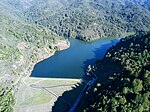Soquel Demonstration State Forest
Soquel Demonstration State Forest (SDSF or SDF) is one of eight Cal Fire-operated Demonstration State Forests totaling 71,000 acres. Collectively, the forests represent the most common forest types in California. The State Forests grow approximately 75 million board feet yearly and harvest an average of 30 million board feet of timber each year, enough to build 3,000 single-family homes. Revenue from these harvests funds a variety of the Department's Resource Management Programs. In addition, the forests provide research and demonstration projects on forest management, while providing public recreation opportunities, fish and wildlife habitat, and watershed protection.The Board of Forestry and Fire Protection (Board) policy provides that the State Forests shall be used for experimentation to determine the economic feasibility of artificial reforestation, and to demonstrate the productive and economic possibilities of good forest practices toward maintaining forest cropland in a productive condition. The management objectives and plans developed for each State Forest are subject to periodic review and approval by the Board.
Excerpt from the Wikipedia article Soquel Demonstration State Forest (License: CC BY-SA 3.0, Authors).Soquel Demonstration State Forest
Flow Trail Segment 6,
Geographical coordinates (GPS) Address Nearby Places Show on map
Geographical coordinates (GPS)
| Latitude | Longitude |
|---|---|
| N 37.080555555556 ° | E -121.90583333333 ° |
Address
Flow Trail Segment 6
Flow Trail Segment 6
California, United States
Open on Google Maps







